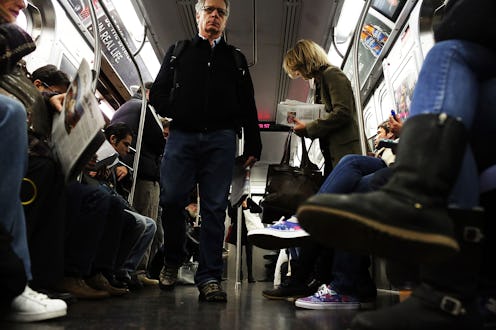News
Did The NYC Ebola Patient Take The Subway?
On Wednesday night, the American doctor now diagnosed with Ebola, Craig Spencer, traveled from his home in uptown Manhattan to Williamsburg, Brooklyn. Having returned from Guinea, West Africa last week, it's unclear why Spencer ended his self-imposed quarantine to meet friends at what's reported to be the The Gutter. Spencer is thought to have taken an Uber back to Harlem, where his apartment has now been sealed off.
Spencer had taken the subway from uptown to downtown New York and then into Brooklyn, which has raised fears in New York that Spencer was symptomatic and could have possibly transmitted the virus to fellow passengers. (Unless the virus is symptomatic, it cannot be transmitted from person to person.) However, as this New York Times article explained earlier this month, it is near-impossible to "catch" Ebola from public transport:
It is extremely unlikely to spread through public transit, for several reasons.
Not all viruses build up to infectious doses in all bodily fluids. For example, measles is coughed out because it first invades cells at the back of the throat, while H.I.V. is not. Norovirus is not a respiratory virus, but such small doses are needed to infect a person that aerosolized vomitus is thought to have sickened many cruise ship passengers. Normally, Ebola does not at first make victims cough or sneeze, although someone who also had the flu could, in theory, spray vomitus or blood. Once Ebola invades the lungs, the body will cough to clear them. But passengers that deathly ill are not likely to be on public transit.
According to the recent W.H.O. statement, high levels of Ebola virus in saliva are rare except in the sickest victims, and whole virus has never been found in sweat. The fluids known to build up high viral loads are blood, feces and vomit.
Spencer rode the A, L, and 1 trains to Brooklyn, where he visited The Gutter. On its Facebook page, The Gutter wrote:
We voluntarily decided to close The Gutter yesterday evening as a precautionary measure while we gathered more information. We are working with the NYC Health Department to have the bar cleaned and sanitized under their supervision and expect to be open sometime today after that is completed. Doctors advising the Health Department have told us that our staff and customers were at no risk.
He then took an Uber back to Harlem. In a statement, Uber said:
We reviewed our records and were able to confirm that one of our driver partners in New York provided a ride to the patient yesterday evening. We immediately contacted the CDC and NYC Department of Health and Mental Hygiene (NYC DOHMH), which stated that neither our driver partner nor any of his subsequent passengers are at risk. We have communicated this to the driver, and the NYC DOHMH medical team met with the driver in person, assuring him that he is not at risk. Our thoughts are with the patient and his loved ones.
In a statement prior to the diagnosis, New York mayor Bill de Blasio said: "Our understanding is that very few people were in direct contact with him."
Later Wednesday, Spencer developed a fever and began to show symptoms of the virus. He notified his hospital and Doctors Without Borders Thursday, and was rushed to Bellevue Hospital. Bellevue is the point of entry for Ebola patients in New York, and has been preparing for such a diagnosis in a New York City resident for months.
Said de Blasio at a press conference Thursday night: "Again, we emphasize: Ebola is very different to contract. Being on the same subway car as someone with Ebola does not put anybody else at risk."
